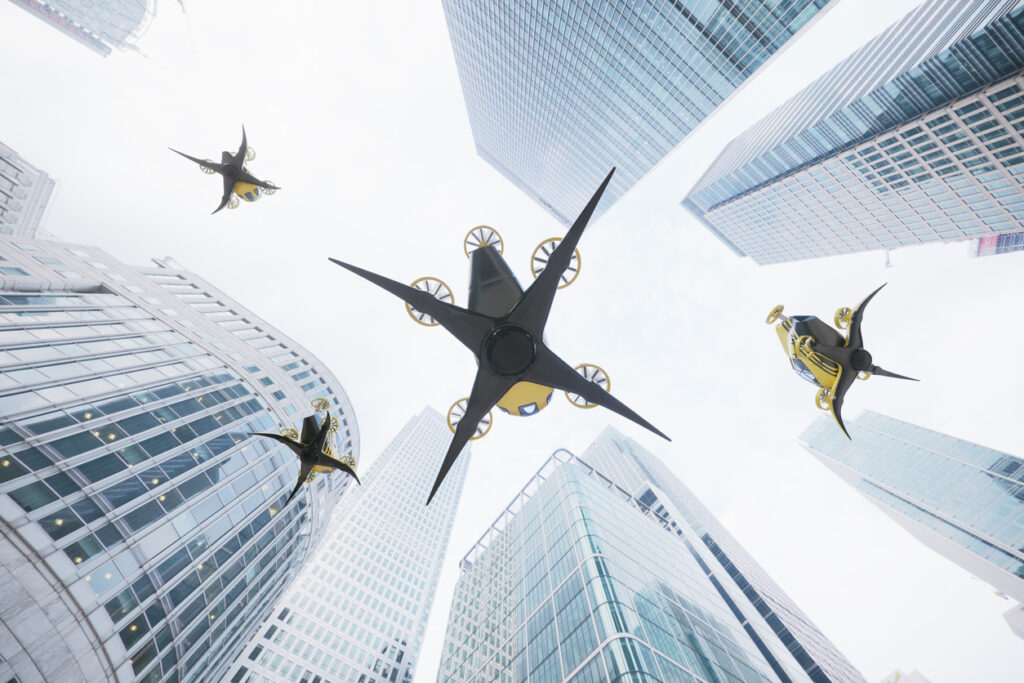Is the reality of flying vehicles already upon us? How will this affect our cities and daily lives?
Flying taxis previously seen only in science fiction movies, soon will appear in the sky. With highly occupied cities and traffic congestion, urban air mobility (UAM) opens up new possibilities for city development and our daily lives. However, the idea is not that simple – to take off, flying vehicles first need places to land.
Flying taxis – sci-fi concept or a reality?
Urban air mobility or aerial commuting is becoming a popular idea for transportation companies. The main focus is on Electrical Vertical Take-off and Landing Aircrafts (eVTOL). According to McKinsey there will be thousands of them flying above cities by 2030. Thus flying taxis can be the next big thing in urban transportation, but is the infrastructure ready?
As per EIT Urban Mobility report, the European UAM market size is predicted to be 4.2 billion EUR by 2030 with forecast to become a reality within 3-5 years. Furthermore, 47% of this report’s respondents agreed that UAM will greatly improve urban mobility and transport, following 57% of experts who agreed that UAM’s opportunities and values outweigh the overall risk.
“We think that similar to what we have with cars today, this [flying vehicle] will be a standard means of transportation for our whole society.”
– Daniel Wiegand, Cofounder and CEO at Lilium Aviation
Benefits of flying vehicles

Urban air transport offers numerous benefits:
- Environmentally friendly
- Reduces air pollution
- Economical
- Faster, quieter and more efficient than ground vehicles
- Does not require tracks and roads (easier to implement infrastructure)
- Best in emergency response and evacuation
- Eventually will be self-driven
Top 5 eVTOLs that are almost ready to “take-off”
Several companies are planning to launch their first UAM vehicles by 2026 and some already have. Among others there are European-based Airbus (France), Lilium and Volocopter (Germany), as well as Japan-based SkyDrive. Prepare yourself for remarkable journeys ahead!
CityAirbus NextGen (2024)
The CityAirbus NextGen represents a cutting-edge prototype of an all-electric, four-seat eVTOL (electric vertical take-off and landing) aircraft. It embraces a lift and cruise concept, offering an impressive operational range of 80 km and a cruise speed of 120 km/h. These specifications make it exceptionally well-suited for a wide range of flight operations within urban environments, providing valuable transportation solutions for cities and communities alike.
The CityAirbus NextGen eVTOL aircraft is currently being assembled by Airbus. The prototype aircraft’s first flight will now take place in 2024.
Archer Midnight (2025)
Archer Aviation’s Midnight is set to redefine the possibilities of air travel, offering an impressive range of up to 100 miles. However, its optimization lies in conducting consecutive back-to-back flights of approximately 20 miles, with a quick charge time of around 12 minutes in between. With Midnight, Archer Aviation, an aircraft manufacturer based in California, aims to revolutionise air travel, combining the benefits of low cost and low noise while upholding the safety standards synonymous with commercial airlines.
Midnight has been designed to prioritise safety, sustainability, and quiet operation. The company is committed to obtaining FAA certification for Midnight by late 2024, paving the way to begin passenger flights in 2025.
Lilium Jet (2025)
In April 2017, a German aerospace company’s eVTOL aircraft named the Lilium Jet flew for the first time. The Lilium Jet is adaptable to various customers and uses, offering optimised configurations for an exceptional experience. It provides a spacious cabin with luxurious club seating for private flights. Alternatively, it can accommodate six seats for passenger flights or be seat-free for zero-emissions logistics.
“Lilium envisions directly connecting inner towns and cities across ranges of between 40 and 200km at launch (and up to 500km longer term) at speeds of up to 300km/h, while enabling significant time savings for individual passengers compared to alternatives.”
– Alastair McIntosh, Lilium’s Chief Technology Officer
Suzuki SkyDrive SD-XX (2025)
Introducing the Skydrive SD-XX, Suzuki’s latest flying car prototype, characterised by its compact design, particularly when compared to the SD-05 model. This sleek aircraft boasts vertical takeoff and landing capabilities, enabling it to operate in diverse locations. Notably, the SD-XX also offers the convenience of driving on the ground after landing. Suzuki aims to launch this futuristic air taxi by 2025, with plans to showcase it at the 2025 World Expo in Osaka, Japan.
Volocopter VoloRegion (2026)
Founded in 2011, Volocopter is a German company dedicated to advancing efficient urban travel through eVTOL aircraft. Pioneering the field, the company achieved a significant milestone in 2011 with the world’s first crewed multi-copter flight. Building on their expertise, Volocopter further developed the VoloRegion, a long-range eVTOL aircraft that successfully completed its inaugural flight in May 2022.
The VoloRegion is a fixed-wing aircraft, equipped with two propulsion fans and six electric motors and rotors, offering extended range capabilities. With a lift-and-cruise design, the VoloRegion can comfortably transport up to four passengers, covering distances of up to 100 km swiftly. It achieves a maximum airspeed of 250 km/h while cruising at a speed of 180 km/h, ensuring efficient and expedient urban travel. According to Volocopter, the VoloRegion eVTOL aircraft will be approved and operational by 2026.
Future of flying vehicles
The future of flying cars and taxis is approaching rapidly as companies invest in and develop eVTOL concepts. These aforementioned examples are just a glimpse of the numerous companies dedicated to transforming transportation. However, challenges in infrastructure, regulatory readiness, costs, public acceptance, and more must be overcome. Nonetheless, the future of flying taxis is closer than we think, leading to a drastic transformation in urban transportation.











